Bees are adorable and I am often in the garden looking for them. One day I came across a big black flying bug which looked like a bee, but something was off. Th
The fuzzy, little creature wasn’t a bee but a fly. I immediately went to the internet and read up about it. These creatures are known as bee flies, and they mimic bees.
Like me, many others have mistaken them for a bee. Maybe, you are one of them too. Read this article till the end to learn about these fascinating creatures and how to distinguish them from bees.
Bee flies – The Bombyliidae
Bee flies are insects belonging to the genus Bombyliidae. In Europe, 335 species are distributed among 53 genera of Bombyliidae. There are at least 4,500 species identities within the Bombyliidae family and it is believed that thousands of others remain undiscovered.
Bee flies come under the family of flies. They are small like bees and resemble bumblebees. They are brown and furry and buzz when they fly. However, they have one wing on each side instead of two. They have huge eyes, slender long legs, and very short antennae, which are not at all like bees’. When bee-flies are at rest, you can tell one wing apart from another but when they’re flying the wings become a blur.
Unlike other bees and insects, these flies do not settle on the flowers while feeding. They feed mid-air with their front legs on the flower and oscillating wings.
They’re abundant in North America, Europe and Asia and are usually found on flowers in sunny, grassy places. They are the main pollinators of certain plant species located in desert areas.
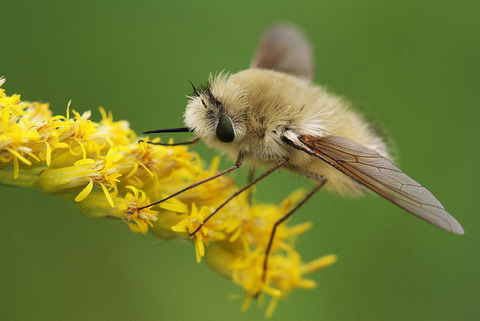
Bombylius major – the parasitic bee mimic fly
Bombylius major is most commonly known as the large bee-fly and the dark-edged bee-fly. It’s the most common insect from the Bombylius family and is often mistaken for a bumble bee.
You can differentiate between a bumble and a B. Major by looking at the number of wings and the shape of the body. Like a bee fly, B. Major also has only one pair of wings. Bumblebees have a round oval body whereas B. Major has a triangular body.
From April to June, you can find B. major in temperate Europe, North America, and portions of Asia, with a concentration in the northern hemisphere. The bee fly species can be found in a wide range of habitats, from desert to arid. You’ll find them most active in the day when it is warm and sunny.
Look closely at the body. There is light hair covering the body but the body itself is dark. The upper half has brown and black hairs and the body is mostly covered with white hairs. You’ll find dark markings on the front half of its wings, and lengthy hairy legs that dangle while flying.
The black wingspan can be anywhere from 8.4 and 14 mm, with a dark brown border. You’ll see a line running horizontally down the center of their brightly decorated wings, separating the black and clear sections.
You might notice that they have longer legs and you’re right in making that judgment. They have longer legs and also a longer proboscis at the front of their head which lets them feed on the nectar from flowers conveniently.
As these insects fly, you can see them rotating around a vertical axis. This feature is unique to B. Major and is known as yawning.
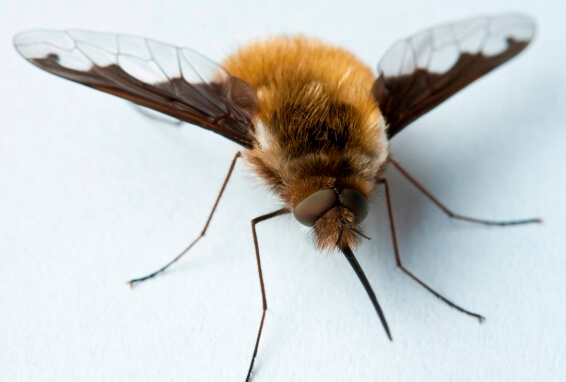
Do these flies carry out the most important function of a bee, pollination?
Do bee-flies pollinate? The answer is, yes. In fact, they do not discriminate. They are generalist floral pollinators which means that they enable pollination of diverse plant families and species. Their proboscis which is longer than a bee with proboscis, is crucial to carrying and transferring pollen.
They can even pollinate up to two thirds of the local flowers in their area. Other species are attracted to the same flowers leading to further pollination.
The parasitic nature of these flies
The large fly that looks like a bee uses the facade in its favor. It mimics the bubble bee enabling close proximity to solitary bee and wasp nests to lay eggs. Some flies even target beetles, ants, moths, or caterpillars.
The birthing process of the flies is very interesting. The female begins by twerking her tummy to gather up sand and pebbles to coat the eggs. She protects and camouflages by the sand, and also adds weight to them by doing this.
She then flies over to the single bee’s nest and flings the eggs out of her abdomen in the hopes that they would hatch near or in the nest. The egg-laying tube of the dark-edged bee-fly has a spine that helps her to flick her eggs.
This enables her to use a technique known as bombing, in which she fires a row of eggs. She’s practically carpet-bombing her eggs while the host has vacated the nest. This chaos might be happening in your garden right now.
The recently hatched bee-fly larvae are quite active. They have artificial legs with which they enter the bees’ burrow. They will cram their cheeks with all of the pollen left for the baby bees. Then a phenomenon happens which is a rarity in nature, a second metamorphosis known as hyper-metamorphosis. They transition into larva which consumes bee grubs making them parasites and they eat other larvae.
Do bee flies sting? Should you be scared of them?
The short answer is no. They might look scary but they’re actually harmless. They cannot bite or sting you.
All they care about is drinking nectar, mating, and laying their eggs.
The easiest way to identify the big black flying bug as a bee fly is by looking at its wings. It is harder to tell them apart mid-flight because the bee fly’s wings move rapidly. You’ll also never see them land on flowers, they hover.
These creatures are very important to the ecosystem and are as good pollinators like bees. And, they’re an absolute joy to have in your garden. No sting, no-hassle, these flies just mind their own business.
Paper wasps
Commonly mistaken for bees, paper wasps are often called ground bees. You might also get fooled by their black and yellow colors. However, the trick is to look at their waist area. A paper wasp is slender and a bee is plump.
Paper wasps are famous for their unique nests. They mix fibers from dead wood and plant stems to fashion umbrella-shaped nests. You’ll find these nests in the eaves of your house, or the branches of a tree in your garden. The material of the next is paper-like and gray or brown in color. Each nest is abandoned in the late fall after a single use.
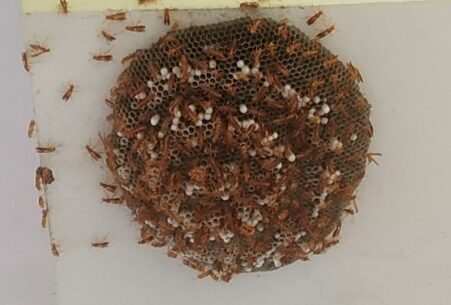
Yellowjackets
If you see a yellowjacket in your garden, consider yourself lucky. These insects collect living and dead insects to feed their babies.
You might want to leave them alone, though. They nest in the ground and protect it very aggressively. Unlike bees, they don’t lose their stinger and die upon stinging. Rather, they’re infamous for repeatedly stinging.
But how can you tell if it’s a yellowjacket and not a bee? Don’t let the yellow and black markings fool you, instead look closely. Yellowjackets are much brighter and hairless. Like wasps, they have a slimmer waist.
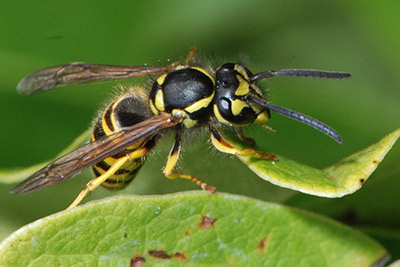
Hornets
About ¾ to 1.5 inches long, these hairless insects closely resemble bees because of their blackish-gray and light yellow markings. However, they’re longer and more slender than bees. They have white markings on their face, thorax, abdomen, and legs.
You’ll find them in the ground or hollow trees in your garden. Carefully inspect wall voids and attics and other areas that are above the ground as they may house hornet colonies. Don’t come within 2-3m of the colony or else the hornets will attack you. Their venom can be deadly, but unless threatened, these insects do not attack.
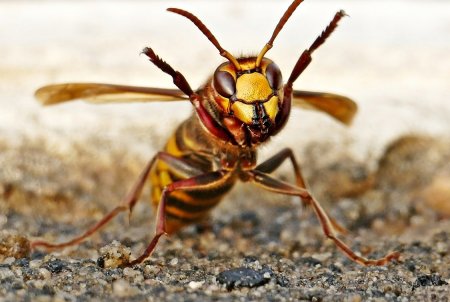
Cicada killers
You might have spotted a giant bee killing a Cicada. Well, that giant bee is in fact, not a bee. It is a cicada killer. They are a category of wasps who consume cicada and larvae.
They are often confused with bees because of the yellow and black markings and the antennas. However, like hornets, they are much slimmer. They have a dull brown head with a small, yellow patch on their face. If you look closely, you’ll see that their thorax is dull brown, almost orange.
They can be anywhere from 1-1.5 inches in size and can leave up to a year. Female cicada killers are infamous for paralyzing their cicadas with their sting and then carrying them back to their lairs. However, you don’t have to worry if you spot one in your yard. These creatures are harmless to humans.
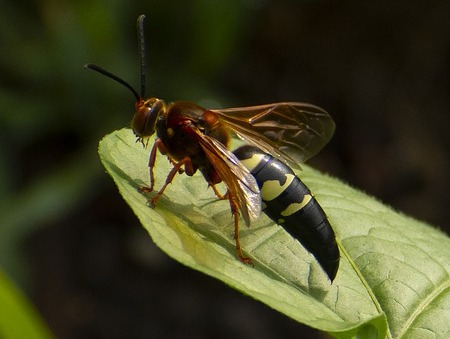
Bee beetle
A bee beetle’s hairy sides and yellow body with black blotches make these insects look deceptively similar to bees. However, unlike bees the patterns on their body aren’t in stripes rather upon a close look you’ll find black patches. They also have shorter antennae than bees and wasps.
Part of the Trichiinae family and the species scarab beetle, they are the most interesting beetles that you’re likely to ever come across. You will find their larvae in rotting birch stumps. The adults are often engaged in what seems like to me, a dance of nature—wrestling on flower heads, competing for nectar.
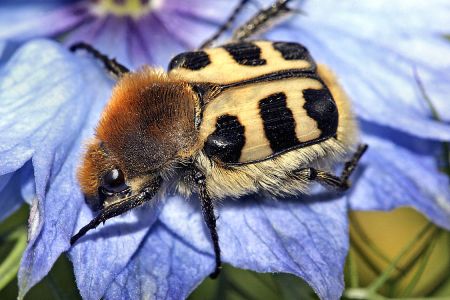
Hoverflies
Hoverflies may look like bees, but believe me, they have a distinct personality worth knowing about. They have a unique spurious vein on their wings distinguishing them from hornets and bees.
They are also known as the ‘farmer’s friends.’ They can live only up to a few weeks. However, in that short duration, they work hard to pollinate plants and crops in many ecosystems earning the title of ‘second-most important pollinator’ only after wild bees.
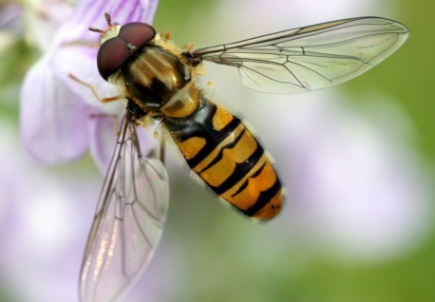
So, the next time you’re having a meal, think about this tiny insect.
Related Articles:
Bee Anatomy Diagram – Study of Honeybee Body Parts